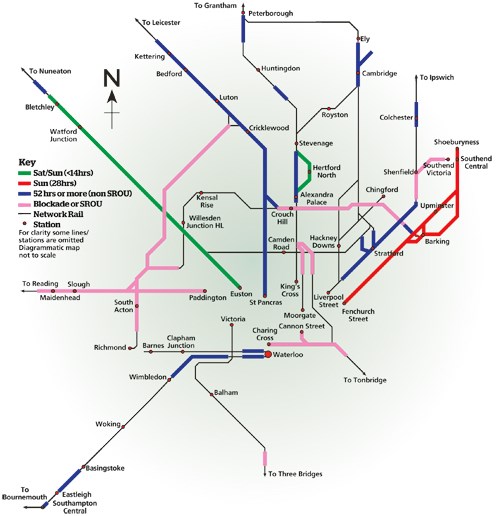The subject on when is the best time to close a line for engineering works is currently under review by the Rail Delivery Group.
“That’s quite a complex question because part of it is around our ability to deliver that work. Clearly, sticking everything into a short period of time a couple of times a year stretches the resources and makes things very much more difficult,” argues Paonessa.
“For example, take the train driver issue. On a normal weekend, when we start running out of train drivers we can usually rustle some up. Frankly, on Christmas Day, you’ve got the train drivers you’ve got - the others are at home with their families, so it makes it that much more difficult because there are that many more constraints.
“If we’re doing all these big activities at certain points in time, there are only so many tilting wagons and there are only so many big Kirow cranes. Buying a whole load more of those is very inefficient, because they’re standing for the rest of the year. So if there’s a piece of work looking at how we can better balance that work out, that’s great.
“I think the other piece which is equally important, and which was quite key at King’s Cross, is that the time of year drives the type of passenger that we have, so that adds a layer of complexity. It also puts the train operators in a difficult position - what do they do to enable us to have longer periods of time in which we can provide a greater level of surety.”
NR is also forced into very long planning lead-times for scarcer resources. Paonessa explains: “At T-8 , it’s a bit late to wake up and say I don’t have enough, which is why we run the process so far in advance. We already have a very clear view of what Christmas 2015 will look like - and it’s full.
“We also know what Easter 2016 will look like, and we have a very good view at the moment of what Christmas 2016 will look like. We’re already matching our plans to make things fit.
“But some of these big activities at Great Western, for example, have so many sequential large activities that can only fit in at one point in time. So our programmes are driven by when Christmas and Easter is, not by what’s best for the programme or is most efficient.
“If we had opportunities to spread that workload out it would have multiple benefits to us as the people doing the work. If I sit with my Network Rail infrastructure projects hat on, I’d love lots of long weekends.
“The flip side of that for the train operators, who are clearly there to serve the travelling passenger, is that it’s very much more difficult in that they have a different set of priorities and a different set of drivers. Ultimately the railway is here to move people around, it’s not here to build bridges and lay track and resignal stuff for its own sake. It’s quite a difficult question, and I’d be very interested to see what the report comes back with.”
So if that’s the story of Christmas, where does it leave Network Rail with its five-year work programme that is just coming to the end of its first year. For renewals alone NR is funded to £12 billion, with track and signalling consuming just over £3bn each and civil engineering around £2.4bn. That brings a considerable amount of work - for example, about 800 miles of conventional plain line rail renewals and about 470 miles of high-output rail and sleeper renewals.
The bill for enhancements is a similar £12bn, with eye-catching electrification projects under way for the Great Western and Midland Main Lines, and Edinburgh-Glasgow. There are also the Northern Hub and East West Rail projects to progress, plus numerous smaller regional schemes.
On top of this, there is Reading and Thameslink to complete, while NR is also playing a key role upgrading suburban lines east and west of London for Crossrail. That project itself will soon move from its Central London tunnelling phase to fitting out, which will demand more railway resources.
And then there’s High Speed 2, which should shift from its planning phase to more detailed railway design work over the next few years. All this, plus London Underground’s continuing modernisation programme, will consume resources. Which begs the question: is there enough to go round?
Paonessa initially appears relaxed, saying: “There’s a broad discussion at actually quite a high level. We have a people steering committee between the three organisations (Network Rail, Crossrail and HS2), which is attended by our respective group HR directors. They get together and look at that national resourcing issue. Different phases of different projects demand different types of resources. We certainly see that at the moment. We have the tools to look at those resource demands and we’re working our way through it.
“Of course, the vast bulk of Crossrail’s surface railway is being done by Network Rail in any case. We’re well on with activities both on the west and east of Crossrail, and doing a really good job. High Speed 2 is in a slightly different phase, but certainly raises all sorts of questions of that smoothing of projects as we move into the back end of CP5 and into CP6.”
Resources needed
To the suggestion that this makes it sound as if there’s not much of a problem, he expands: “I think it really depends on what fits in where, and what are the major schemes that are also potentially happening in the railway at the same time.












